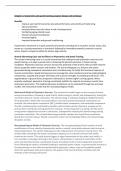Samenvatting
Samenvatting essentials of personal training 3e editie (hoofdstuk 17 t/m 23)
- Instelling
- Hogeschool Van Amsterdam (HvA)
Hierbij een uitgebreide samenvatting van hoofdstuk 17 t/m 23 van NSCA essentials of personal training (3e editie), alle hoofdstukken zijn duidelijk omschreven en ik heb de minor afgerond met een gemiddelde van een 9. English: Here is an extensive summary of chapter 17 t/m 23 of NSCA essentials of p...
[Meer zien]





